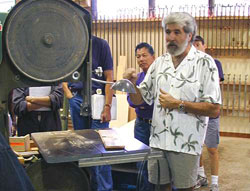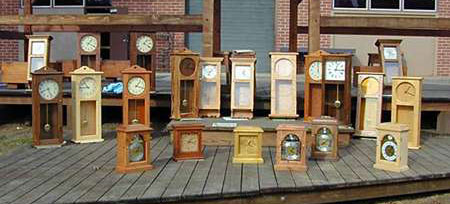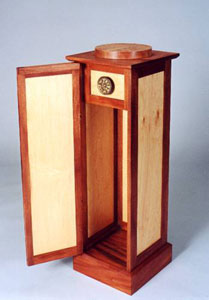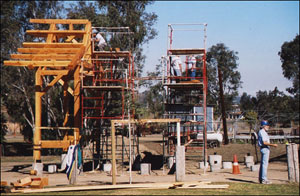
Sixty years ago, Palomar College was founded in San Marcos, California as a community college for the humanities. Fifty years ago, a woodworking program was started there by Everett Robertson. Today, the woodworking program boasts three full labs and three classrooms and teaches some 2,000 students per year, making it by far the largest woodworking school in the country.
Students range in age from 16 to 80, and there is no previous experience required to attend. “We focus on teaching them safety first,” said Russ Filbeck, a long-time teacher at the school. “They start by learning to use hand tools and how to square lumber from rough stock. In each class, the students will create some type of skill-building project. In the beginning class, they are required to build one of four styles of clocks, but from that point on, they will be designing and building their own project.”
There are over 50 different classes, and they are usually filled. Each class has 25 to 30 students, and the labs where the actual woodworking takes place are busy from Monday through Saturday, and five nights a week as well. Although they take students from all over, the school’s main focus is the local southern California area. As a consequence, there is no on-campus housing, and courses are frequently arranged so that commuting students can attend classes just one day a week.
“All students are required to start with a ‘fundamentals of woodworking’ class, where they learn about safety, hand tools, machine tools and sharpening, all while building a clock,” Filbeck explained. “That class is 16 weeks at eight hours per week. In their second semester, they learn about hand planes, cabinet scrapers and so forth, and build a larger project, such as a cabinet with a door and a drawer.”

Because the school is state-funded, it costs only $26 per unit for California residents. Most classes are either two or four units, though you must also pay for materials. Of course, out-of-state tuition is substantially higher. The woodworking faculty has five full-time and around 15 part-time teachers covering such topics as veneering, furniture making, hand tool making, hand tool joinery, machine joinery, wood bending, finishing, cabinetmaking, carving, jigs and fixtures, tool maintenance and a wealth of other skills. It’s a curriculum geared toward traditional furniture making as opposed to production manufacturing.
“After you get through the first two courses, you can take any other courses you like,” Filbeck said. “We encourage students to focus on either advanced furniture design and building, cabinetmaking or a combination of the two. It is a very structured program; it is not a free-for-all. Once they complete the program, many of our students start their own businesses, or work for cabinet shops all over the area, though many are simply hobby woodworkers studying for their own edification.

“There’s also a timber framing class, started in 1997, that draws students from all over the U.S. and Canada,” Filbeck continued. “Each year, a timber frame structure is designed and built during a two-week period either on the campus or on-site for a local community project that needs a building. On the final day of class, the building is erected and joints fitted, much like an Amish barn raising. Five of the structures are here on campus. We’ve made buildings for the music and art departments, one to house the campus sawmill, a steeple-topped ‘friendship building’ near the library designed as a gathering place for people to visit and talk and even a pavilion for a local bluegrass festival venue.”
Palomar also has an urban forestry program, a partnership between the college and the local San Diego community to harvest trees from the city, parks and zoo so that the logs don’t end up in landfills. “The California department of forestry came to us in 2000 offering us a portable sawmill and a kiln if we would harvest logs and convert them to usable wood. That includes logs that fall from wind, fall prey to building and road expansion, and any old or dangerous trees that must be removed. We keep the wood and give the city a letter that indicates its value as a tax deduction. The city saves money by not having to put the logs in landfill, and the school gets the wood.”

The program has expanded, and offers students a unique opportunity. “We now have two kilns, and our sawmill is housed under one of the student-built timber frame structures. As a result of this program, our students get to work with black acacia, Torrey pine, carob and other beautiful local woods that they might not normally be able to buy. Torrey pine, for example, is only located in the coastal chaparral of San Diego County. Being unique to this area and a protected species, it can only be harvested with permission. Our students can buy this lumber at very reasonable prices for their projects.”
In 2003, the school added a cultural exchange program, starting with a trip to Japan to attend Kezurou-kai, a Japanese woodworking conference which includes temple building, blacksmithing and tool making. One high point is the thin shaving contest, where hand plane experts show off their skills making wood shavings as thin as four microns. That’s thinner than .0002″ (two ten thousandths of an inch), or roughly one tenth the thickness of a human hair.

“Before we go to Japan,” described Filbeck, “we build and finish a chair, and disassemble it for shipping. During the conference, we assemble the chair, weave a hickory bark seat, then present it to a chosen Japanese craftsman. The first chair went to the man who started Kezurou-kai. He started the conference out of frustration with seeing Japanese youth who would rather work in Disneyland than maintain their thousand-year-old traditions.”
Here on the home front, Palomar has spent 50 years helping to keep our woodworking traditions alive. There’s little wonder that they are so proudly celebrating this landmark anniversary with a special logo that will adorn tool aprons, hats and other memorabilia. “For the past three years,” Filbeck told me with obvious pride, “Sam Maloof has attended our graduation ceremonies. Hopefully, he’ll join us again this year for our 50th.”





